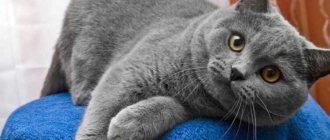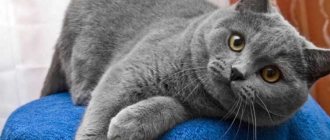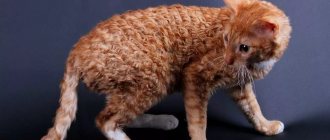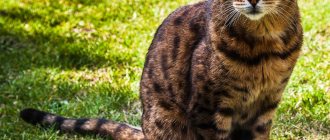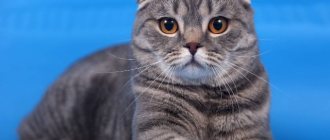The Celtic breed or European Shorthair cat was only recently recognized in the mid-twentieth century. The purpose of isolating this breed is to preserve the original appearance of ordinary domestic cats inhabiting the cities and suburbs of Europe. One of the most important advantages of these animals is their strong hunting qualities.
The first of those who began to breed European Shorthairs were breeders from countries such as Norway, Denmark and Sweden. Later, felinologists from France and Britain joined. In France today there are cats of blue color, called “tents”. In some countries, Celtic cats are called Carthusian. Breeders from England worked to breed large cats with a developed body, a round muzzle and dense fur. Later, it was from these cats that the beloved British breed originated.
It was only in 1982 that the Celtic cat breed was recognized as an independent breed. Now these cats, classified as shorthaired, hold the record for the number of variants of different colors. Only Oriental Shorthair and Persian cats can compete with them in this. They are one of the universal breeds that can live both in a city apartment and in a private home. At first, these cats may seem too simple, but their value lies in their naturalness.
Description of Celtic breed standards:
[advertising]
- the body has a medium size closer to large, developed muscles, flexibility, weight from 4 to 8 kg;
- a developed chest has a rounded shape;
- legs of medium length, strong and strong, paws large and oval;
- the tail is short, tapering at the tip;
- the head is wide, shaped closer to a triangle, with a straight nose and clear cheekbones;
- the neck is short and strong;
- the ears are not very large, rounded at the tips, sometimes with tassels, set wide apart and directed vertically;
- the eyes are round, expressive, wide open, the color matches the coat;
- The coat is short, dense, silky and shiny, and comes in many colors.
Origin story
Once upon a time there were yard cats in the world. They lived a very long time ago, crawled through garbage dumps in search of food, and caught rodents.
The smartest or luckiest sometimes ended up in human dwellings and continued to exist there, trying to repay food and shelter by killing mice and being smart.
Centuries passed, and yard cats hardly changed, either in appearance or in character. Independent animals perfectly adapted to the harsh conditions of survival on the street and were not very eager to be domesticated.
Breeders became interested in this independence, and by the end of the 20th century they developed a new breed, using as a basis yard cats - excellent hunters, famous for their unpretentiousness.
Basics of proper nutrition
Your four-legged friend's menu may include ready-made food or natural ingredients. If you choose the first option, make sure that the food contains at least 30% meat. It should not contain milk, sweet additives or offal. Always pay attention to the composition indicated on the package and the expiration date.
To read: Signs of difference between the Cardigan Welsh Corgi and Pembroke Welsh Corgi breeds
Buy food from trusted manufacturers or on the recommendation of breeders. Don’t take what is imposed on most consumers; don’t skimp on quality food for your pet.
If you want to provide your animal with natural nutrition, do not be lazy in purchasing fresh and healthy food for it. This is the guarantee of his health. The diet should be based on lean meat. It can be eaten raw , then more useful components are retained. It is allowed to give fish and offal. Stewed vegetables and fermented milk products are suitable additions. Give your cat vitamin supplements periodically.
It is advisable to feed on a schedule - at the same time. For kittens, 3-4 times a day is enough, and for adults – 1-2 times. Be sure to place a bowl of clean water nearby so that the animal can always quench its thirst.
Interesting Facts
The development of a new breed began almost simultaneously in Norway, Denmark and Sweden. A little later, England, Germany, and France joined this process.
And if the first three got a Celtic or Swedish domestic cat (in Sweden), then the second three called their creation a European (or British) shorthair cat. France went even further and gave its pets the name “chartreuse”.
Later, the United States got involved and developed its own breed, calling it the American Shorthair cat.
The confusion over the names was ended in 1982, when the breed standard was recognized and the name “Celtic” or “European Shorthair” was established.
The breed is not particularly popular among followers of fashionable cats, as it has the most ordinary appearance and independent character, which it will not fail to show to its owner.
But for connoisseurs of simplicity and reliability, these animals are simply irreplaceable.
A photo of a Celtic cat is practically no different from a photo of a simple street cat.Character traits
Thanks to the work of felinologists, the breed is endowed with all the advantages of cats and has virtually no disadvantages. Celtic cats do not require much attention, but at the same time, they are nimble and funny cats and will not wander.
- They have a high level of intelligence (a similar level is attributed to Russian blue cats), even tricky problems are not a problem for the Celts.
- They are very sociable and curious, sociable, but at the same time they can calmly remain alone, finding things to do on their own.
- The owner for them is not the crown of nature, his desires are not always the law. If a cat doesn't like something, she won't tolerate it.
- Celts also caress only when they feel like it.
Celtic cats choose their own authorities – there will be no problems with obedience if the owner’s habits and daily routine suit the cat. But you should remember that these cats have their own opinion on everything, and only this is what they consider correct.
You cannot subjugate them, but you can learn to negotiate. Representatives of the breed are peaceful towards strangers, but will not tolerate familiarity even from small children. Only those who will not torture them or try to pet the cat against its will will be allowed to play with themselves.
Celts are quite playful and are never averse to mischief. For safety, you should acquire the necessary toys and arrange a place for games.
As for other animals in the house, the attitude of Celtic cats towards them most likely depends on the individual characteristics of a particular individual. Some Celts can't stand other animals, while others get along well not only with other cats, but also with dogs, and even with rodents and birds.
Caring for a European cat
An animal of this breed does not require special care. The cat will wash smooth fur on its own, and tangles will not form, since the fur is too short for this. If desired, the cat can be brushed periodically, but this is not necessary.
The cat has good health and strong immunity.Education and physical activity
Representatives of the European Shorthair breed are intelligent, smart and independent. In the process of raising and communicating with a Celtic cat, you need to be respectful and patient. The animal is well versed in the intonations of the human voice.
Demandingness and affection, perseverance and consistency will help in raising an obedient and equal family member. Screaming and rough handling will make a neurasthenic out of the Celtic Shorthair.
To prevent your cat from damaging the furniture, you need to purchase a scratching post. The European Shorthair should be provided with a place for outdoor games and climbing. It is necessary to remove all objects that could break from horizontal surfaces. Wires from electrical appliances are supposed to be hidden from the Celtic cat.
The ideal option would be to purchase a special complex for cats. Pet stores have a large selection of interactive toys. Having fun with them, a European shorthair cat can keep itself busy for a long time.
Celtic cat price
The cost of kittens depends on their pedigree and varies from 5,000 to 30,000 rubles. However, you need to be especially vigilant with this breed - instead of a purebred animal, you can easily buy an ordinary yard Murzik. In principle, no one will notice the difference.
The Celtic cat is a rather rare breed for Russia; not all breeders breed it, and to the question “Where to buy a Celtic cat” it is better to look for the answer on the Internet or check with any cat club.
Appearance
Most often the size of individuals is medium, although large specimens are also found. Animals are strong, strong and quite flexible. Males can weigh eight kilograms, and females are two times lighter.
Celtic cats are distinguished by a harmonious physique with a powerful chest, muscular slender legs and a thick tail that gradually tapers to the tip.
- Round, wide eyes, quite widely spaced from each other, go well with a straight and even nose.
- The color of the eyes does not matter, it should be in harmony with the color of the coat.
- Heterochromia is not considered a deviation from the norm, nor is the presence of tassels on small, slightly rounded ears.
Despite the short length, the coat is thick, with a dense undercoat, and silky. According to the description of the Celtic cat breed, the Siamese color, as well as red-brown, lilac, light beige and chocolate, are considered non-compliance with the standard.
Photo of a Celtic cat
Read here Chausie - a detailed description of the breed and the character inherent in the breed. 120 photos and descriptions of the appearance of cats
Help the site, share with friends 
Diseases and breed defects
Perhaps this is one of the rare cat breeds whose body does not suffer from hereditary diseases . The immunity of the Celtic cat has been forged over centuries and has not been spoiled by the noble blood of other, often pampered breeds. The only source of danger for EKSH are considered to be infections that even a cat sitting in an apartment can pick up: bacteria/viruses enter the house along with clothes and shoes.
This is interesting! Vaccination is prohibited during the period of teeth change. In cats, the process begins at four months of age and is completed by 7 months.
The first vaccinations for kittens are given at 8 weeks (if the cat was not vaccinated before birth) or at 12 weeks (with prenatal vaccination). 10 days before immunization, kittens are dewormed.
Sterilization and castration
If the owner of the Celtic beauty does not plan to regularly produce offspring, the animal should be sterilized (cat) or neutered (male). This can be done when the European pet reaches the age of 8-9 months. The time for the operation must be chosen correctly: females should not be in heat, and males should not be in heat.
There is no need to be afraid of interference. If it is performed by an experienced specialist under anesthesia, it will not cause harm.
It is much more dangerous to regularly suppress the sexual instinct with hormonal drugs. If used frequently, they can cause irreversible changes in the body of a European cat.
Tumor and cystic formations often occur in the abdominal cavity. In this case, complex surgical intervention cannot be avoided, and the postoperative period will be difficult.
How to choose the right kitten
For a purebred Celtic Shorthair kitten, you should contact only special nurseries or trusted breeders.
The key to making the right choice is that the parents of the European baby have the appropriate documents about the breed ─ passports or certificates. They are transferred to the buyer upon sale.
You should pay attention to the appearance of the mother. There must be pronounced signs of the European Shorthair breed and compliance with the standards.
Typically, kittens are weaned from their mother and sold at 2.5 months. By this time, children are supposed to undergo anthelmintic treatment and vaccination and have a certificate about this from a veterinarian. The short-haired European animal must be litter trained and feed on its own.
The character of a two to three month old Celtic kitten is already clearly expressed. The future owner chooses a companion in accordance with his own temperament and needs.
Kitten care
No special skills are required in caring for a short-haired European baby. All he needs is attention and affection. At first, the new owner will have to replace the European kitten’s mother ─ kind, but strict.
It is immediately necessary to determine the place of feeding and toilet for the pet and ensure strict compliance with the rules.
At first, you will have to devote more time to your short-haired European baby, pick him up more often, and stroke his tummy so that there are no problems with stool.
Later, when the new tenant gets comfortable in the house, he will find something to do with himself. To keep your little Celtic European physically active, you can purchase several toys.
In general, caring for kittens is the same as for adult European purrs.
A short-haired Celtic baby should be fed frequently, in small portions, by chopping the food. Experienced breeders recommend leaving food overnight. Special food for kittens, dry and wet, is best suited for nutrition.
Your veterinarian will recommend vitamin supplements. Babies have a high metabolism, they quickly become hungry. After changing teeth, at 7-8 months of age, a European kitten can be switched to adult food.
Knitting features
The first mating of a European cat should take place at the age of approximately 1.5 years. Most Celts are in their third heat by this time. The first thing the owner should do is examine the cat and make sure it is healthy (deworming, vaccination, etc.). It is advisable to look for a partner with experience. To give birth to beautiful, healthy and purebred kittens, you need an equally good partner for your cat. In such cases, they usually turn to professional breeders or felinological (breeding) organizations.
Mating can be paid or barter (1 or several kittens will need to be left to the other party). If your Celt is a champion, then your partner must also have the appropriate documents. Some Celtic owners breed their cats with representatives of other breeds, but such owners are considered unscrupulous - such crossings are prohibited.
Pregnancy in Celtic cats is easy, and childbirth usually occurs without complications. Cases of the birth of “rejected” kittens are rare. If you don’t need Celtic offspring, then the cat or female cat needs to be spayed/neutered. You don’t have to wait 1.5 years for this. The procedure can be performed when the animal is 8–9 months old. Sometimes owners miss this period, and the cat may go into estrus (or heat in males). When searching for a partner or preparing for surgery, owners often resort to hormonal drugs. However, this is not recommended, since “silencing” instincts can adversely affect the health of the animal.
It is not recommended to crossbreed a European Shorthair cat with representatives of other breeds.



